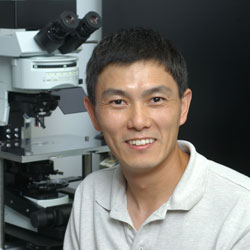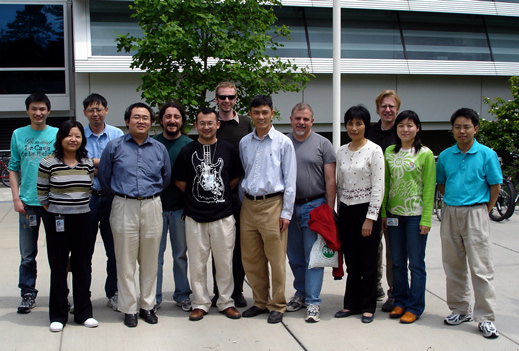| |
| |
| Ling-Gang Wu, M.D., Ph.D., Senior Investigator |
 |
Dr. Wu received his M.D. in 1985 from Second Military Medical College, Shanghai, and his Ph.D. in neuroscience in 1994 from Baylor College of Medicine, where he worked with Peter Saggau studying the role of presynaptic voltage-dependent calcium channels in controlling transmitter release. From 1994 to 1996 he did postdoctoral training with William J. Betz at the University of Colorado Medical School, where he studied the kinetic regulation of endocytosis at frog neuromuscular junctions using FM dye imaging. From 1996 to 1999 he a second postdoctoral fellowship with Bert Sakmann at the Max Planck Institute in Heidelberg, Germany, where he identified calcium channel types and studied the presynaptic mechanisms underlying short-term synaptic depression at a giant nerve terminal, the calyx of Held in rat brainstem. From 1999 to 2003 he was an assistant professor at Washington University in St. Louis, where his laboratory applied capacitance recording techniques to study regulation of the kinetics of endocytosis at the calyx of Held. Dr. Wu joined NINDS as an investigator in 2003 and was promoted to senior investigator in 2007. His laboratory is using electrophysiological, imaging, as well as biochemical and molecular biological techniques, to investigate the cellular and molecular mechanisms underlying generation and regulation of endocytosis and synaptic plasticity at the calyx-type synapse.
|

|
Staff:

- Mrs. Li Bai, M.S., Technician, (301) 451-3332 bail@ninds.nih.gov
- Abdeladim Elhamdani, Ph.D., Research Fellow, (301) 451-3356 elhamdania@ninds.nih.gov
- Dr. Junmei Fan, Ph.D., Visiting Fellow, (301) 594-1287 fanju@ninds.nih.gov
- Dr. Liming He, Ph.D., Research Fellow, (301) 451-3358 helim@ninds.nih.gov
- Mr. Benjamin McNeil, B.S., Graduate Student, (301) 451-2284 mcneilb@ninds.nih.gov
- Dr. Kenneth Paradiso, Ph.D., Research Fellow, (301) 451-3341 paradisk@ninds.nih.gov
- Dr. Jiansong Sheng, Visiting Fellow, (301) 451-3334 shengj@ninds.nih.gov
- Dr. Wonchul Shin, Visiting Fellow, (301) 451-3335 shinw@ninds.nih.gov
- Dr. Tao Sun, Ph.D., Visiting Fellow, (301) 451-3339 suntao@ninds.nih.gov
- Dr. Xin-Sheng Wu, Ph.D., Research Fellow, (301) 451-3345 wux@ninds.nih.gov
- Dr. Jianhua Xu, Ph.D., Research Fellow, (301) 451-3340 xuj@ninds.nih.gov
- Dr. Lei Xue, Ph.D., Postdoctoral Fellow, (301) 451-3357 xuel@ninds.nih.gov
Research Interests:
Neurons communicate with each other via chemical synaptic transmission. Regulation of the strength of synaptic transmission plays essential roles in many physiological and pathological processes, such as control of neuronal network outputs, neuronal development, learning and memory, and neurological diseases. It remains poorly understood how synaptic strength is controlled at nerve terminals. Filling this gap of knowledge is the goal of the Synaptic Transmission Unit.
Synaptic strength is measured as the postsynaptic response to transmitter release induced by calcium-triggered vesicle fusion during a presynaptic action potential. It is proportional to the product of three parameters: RRP, p, and q. RRP stands for the size of the readily release pool, p refers to the release probability, and q is the quantal response to single vesicle fusion. Most forms of synaptic plasticity are achieved ultimately via regulation of these three parameters. Accordingly, our research is approximately divided into three parts. First, we study the molecular and biophysical mechanisms mediating vesicle endocytosis, a process that recycles synaptic vesicle and thus maintains RRP. We also explore the role of endocytosis in synaptic transmission and plasticity. Second, we studied how calcium channels control release probability, and how regulation of calcium channels leads to synaptic plasticity. Third, we study how quantal size and kinetics are controlled and regulated.
Presynaptic mechanisms are difficult to study because most nerve terminals are too small to access. Here we use a large, glutamatergic, calyx of Held synapse, where both the nerve terminal and the postsynaptic neuron can be patch-clamped. We have established the capacitance measurement technique at the calyx, which allows us to study endocytosis and exocytosis directly at nerve terminals. The ability to apply these advanced techniques makes the calyx an ideal preparation for our research goal. These advanced techniques are combined with techniques in molecular biology, imaging, electron microscopy, and computer simulation to understand presynaptic mechanisms controlling synaptic strength.
|
Selected Recent Publications:
Xu J, McNeil B, Wu W, Nees D, Bai L, Wu LG. (2008) GTP-independent rapid and slow endocytosis at a central synapse, Nat Neurosci. 11(1), 45-53.
Full Text/Abstract
He L, Wu LG. (2007) The debate on the kiss-and-run fusion at synapses., Trends in Neuroscience 30(9), 447-55 .
Full Text/Abstract
Xu J, He L, Wu LG. (2007) Role of Ca(2+) channels in short-term synaptic plasticity., Curr Opin Neurobiol. 17(3), 352-9.
Full Text/Abstract
Wu LG, Ryan TA, Lagnado L. (2007) Modes of vesicle retrieval at ribbon synapses, calyx-type synapses, and small central synapses, J Neurosci. 27(44), 11793-802.
Full Text/Abstract
He L, Wu XS, Mohan R, and Wu LG. (2006) Two modes of fusion pore openings revealed by cell-attached recordings at a synapse, Nature 444, 102-105.
Full Text/Abstract
Xu J and Wu LG (2005) The decrease in the presynaptic calcium current is a major cause of short-term depression at a calyx-type synapse., Neuron 46, 633-645.
Full Text/Abstract
Sun JY, Wu XS, Wu LG (2002) Single and multiple vesicle fusion induce different rates of endocytosis at a central synapse, Nature 417, 555-559 .
Full Text/Abstract
All Selected Publications
Contact Information:
Dr. Ling-Gang Wu
Synaptic Transmission Section, NINDS
Porter Neuroscience Research Center
Building 35, Room 2B-1012
35 Convent Drive, MSC 3706
Bethesda, MD 20892-3706
Telephone: (301) 451-3338 (office),
(301) 451-3338 (laboratory),
(301) 480-1466 (fax)
Email: wul@ninds.nih.gov
|
|















